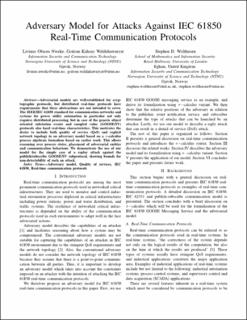Adversary Model for Attacks Against IEC 61850 Real-Time Communication Protocols
Peer reviewed, Journal article
Accepted version

Åpne
Permanent lenke
https://hdl.handle.net/11250/2673894Utgivelsesdato
2020Metadata
Vis full innførselSamlinger
Originalversjon
10.1109/DRCN48652.2020.1570604241Sammendrag
Adversarial models are well-established for cryptographic protocols, but distributed real-time protocols have requirements that these abstractions are not intended to cover. The IEEE/IEC 61850 standard for communication networks and systems for power utility automation in particular not only requires distributed processing, but in case of the generic object oriented substation events and sampled value (GOOSE/SV) protocols also hard real-time characteristics. This motivates the desire to include both quality of service (QoS) and explicit network topology in an adversary model based on a π-calculus process algebraic formalism based on earlier work. This allows reasoning over process states, placement of adversarial entities and communication behaviour. We demonstrate the use of our model for the simple case of a replay attack against the publish/subscribe GOOSE/SV subprotocol, showing bounds for non-detectability of such an attack.